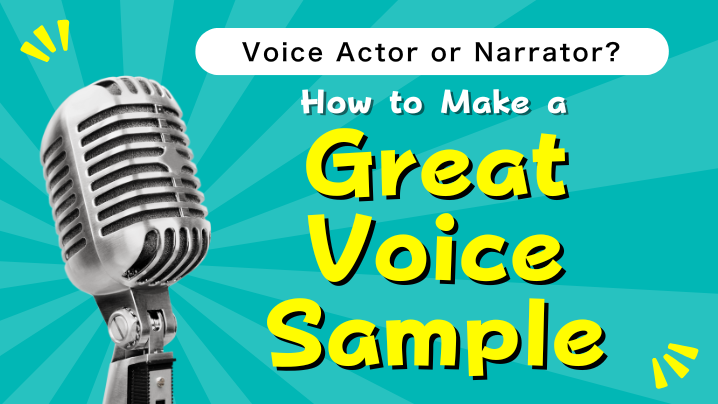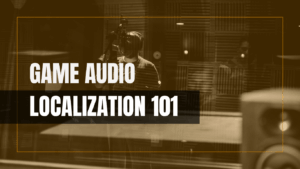For anyone aiming to work as a voice actor or narrator, a voice sample is absolutely essential. It’s the key tool for highlighting your voice quality, emotional expression, and acting ability!
In this post, we’ll walk you through everything you need to know about creating a voice sample: how to make one, important tips to keep in mind, typical costs, and common pitfalls to watch out for!
The Importance of a Voice Sample
A voice sample is a short recording that showcases your vocal qualities, the types of characters you can play, and the range of expressions you can deliver. For voice actors and narrators, it’s an essential part of their promotional materials – consider it a cover letter for your voice!
In fact, a single voice sample can sometimes be enough to land you a role, making it an incredibly important tool in the industry.
For some auditions, casting teams will start by collecting a wide range of voice samples for their first round of screening. That’s why it’s crucial to create a voice sample that’s original and clearly and concisely communicates who you are: your vocal style, your strengths, and your performance skills.
How to Create a Voice Sample
Creating a voice sample generally involves three main steps:
- Preparing your script
- Rehearsing
- Recording & editing
Before you even start writing or selecting a script, it’s helpful to have a clear understanding of what types of characters suit your voice, what kinds of performances match your vocal tone, and what your vocal strengths are.
① Preparing Your Script
Dress (or, in this case, perform) for the part you want! If you’re aiming to become a narrator, you’ll want to prepare a narration-style script. And if you’re pursuing character voice work (such as for anime or games), a character dialogue script will be more appropriate.
Of course, many people prepare both types depending on the kinds of work they’re interested in, so feel free to tailor your materials to your goals.
While you can find plenty of sample scripts online, it’s not recommended to use them as-is.
Why?
Using widely available scripts increases the risk that your lines will overlap with those of other applicants. If your sample sounds identical to someone else’s, it may be harder for casting directors to remember you or for your voice to stand out.
Additionally, poorly written or awkward scripts can make it harder to convey the setting or emotional context, which in turn makes it difficult to showcase your unique personality and acting skills.
That said, even with original material, you should avoid making all your characters too similar. This can give the impression that your range as a voice actor is limited.
Instead, try to include a variety of roles: incorporate samples for different personalities, ages, and tones to highlight your vocal versatility.
Also keep in mind that most voice samples should be short and sweet. You should aim to keep your entire voice sample, including a brief self-introduction, to under two minutes.
This helps maintain the listener’s interest and ensures they’ll make it through to the end.
Key Takeaways
- Create your own original scripts whenever possible
- Include a variety of roles and situations to show off your range
- Keep your full voice sample, including your self-introduction, under 2 minutes
② Rehearsing
Once your script is ready, it’s time to start rehearsals!
Don’t just read the script aloud – record yourself and listen back every time. Hearing your own performance from a listener’s perspective will help you identify areas for improvement and polish your delivery.
Of course, it’s important to create something you’re personally happy with. But even more crucial is how effectively your personality and strengths come across to others.
In just two minutes, your goal is to clearly communicate who you are and what you bring to the table, and to leave the listener thinking, “I’d love to hear more from this person.”
Key Takeaways
- Record and review repeatedly!
③ Recording & Editing
After you’ve rehearsed, it’s time to record your voice sample. Choose the quietest space possible for recording. If you’re recording at home, be mindful of unexpected background noises, like housemates talking or a doorbell ringing. These types of sounds can easily get picked up and compromise the overall quality of your recording.
For audition-ready voice samples, quality matters. That’s why we highly recommend recording in a professional studio whenever possible.
Many studios also offer services like removing lip smacks, fixing audio clipping, and other cleanup that can help you create a polished, professional-grade sample.
As for post production, there are some varying approaches to the inclusion of background music or sound effects. For character voice acting samples, it’s generally recommended to avoid background music or sound effects, as it is best to let your acting stand on its own rather than rely on other crutches for characterization. For narration samples, however, adding music or sound effects can sometimes enhance the impact, depending on the context.
Make sure to tailor your voice sample to your goals, whether it’s voice acting or narration, and adjust your use of sound accordingly.
Key Takeaways
- Record in as quiet a space as possible
- For audition samples, studio recording is strongly recommended
- Post production
- Voice acting: generally not necessary to include background music or sound effects
- Narration: may be helpful to include background music or sound effects in certain cases
Recording a Standout Voice Sample
If you’re planning to record your voice sample at home, it’s important to have both the right environment and proper equipment to ensure your voice is captured clearly.
Basic Equipment & Setup for Home Recording:
- A quiet space free from noise and distractions
- A condenser microphone
- An audio interface
- A computer
- Audio editing software
- A microphone stand
- A pop filter
If you can’t get your hands on all of the above, try to at least have a quiet environment, a voice recorder capable of linear PCM recording, a computer, and editing software.
※What is Linear PCM?
Linear PCM (Pulse Code Modulation) is an uncompressed audio format used on CDs. Since it records audio without compressing it, it captures your voice exactly as it is, making it ideal for high-quality recordings.
Keep in mind that if you’re recording on your own, you’ll be handling everything from the recording to the editing, which can be time-consuming and may require some financial investment.
What About Recording on a Smartphone?
Technically, you can record a voice sample using your smartphone – and we actually recommend it for practice or self-review. As long as you’re in a quiet space, it’s a convenient way to get started.
However, for auditions or professional submissions, smartphone recordings are not recommended. Even with high-quality apps or external mics, phone recordings still fall short compared to studio-level audio.
Your voice sample is your calling card. When it matters most, like in an audition, it’s best to record in a professional studio environment. Not only will the quality be superior, but it also gives a much better impression to whoever’s listening.
Key Takeaways
- Home recording is possible, but prioritize a quiet space and proper gear
- For serious submissions, studio recording is the best choice
- Match your recording method to how the voice sample will be used
How Much Does It Cost to Record a Voice Sample?
From writing scripts and recording to editing the audio, completing all the steps of a voice sample on your own can be quite a challenge.
And even if you decide to go with a professional studio for the recording, you’re probably wondering: how much does it actually cost?
Below is a general guide to the typical costs for creating a voice sample in Japan, whether you’re recording at home or in a studio. Please note that these are average domestic estimates and can vary depending on location, services included, and studio quality.
| Recording Location | Rough Cost |
|---|---|
| Home Recording ※Assumes you handle the recording and audio editing yourself, and only outsource the scriptwriting. | JPY 5,000〜20,000 |
| Studio Recording ※Includes scriptwriting, studio recording, direction, and audio editing. | JPY 30,000~100,000 |
Below is a general breakdown of typical rates for each component involved in voice sample production. Please use this as a general reference, as actual costs may vary depending on the provider and services offered.
| Item | Estimated Cost |
|---|---|
| Script Creation | JPY 5,000〜20,000 |
| Studio Fees | JPY 10,000〜30,000 |
| Director Fees | JPY 10,000〜50,000 |
| Audio Editing & Mixing | JPY 5,000〜30,000 |
Studio fees can change significantly depending on the size of the studio and the equipment available.
Depending on the provider, you’ll find a variety of plans: from full-service packages that include direction, editing, and noise reduction (similar to what you’d get in a professional studio), to more budget-friendly options that focus solely on recording and basic editing.
When creating a voice sample for important situations like auditions, it’s essential to showcase the best of your vocal abilities. We especially recommend that first-time creators choose a plan that includes direction and editing, or to record in a professional studio used by working voice actors. With a direction-included plan, you’ll receive objective feedback from someone with deep industry experience, making it a great way to level up your voice sample.
5 Important Tips for Creating a Voice Sample
Here are five key points to keep in mind when creating your voice sample:
① Ensure Proper Pronunciation, Accent, and Intonation
Clear intonation and articulation are absolutely vital for voice actors and narrators. Be mindful of how clearly you pronounce consonants like s / t / k, and whether you’re using the correct accent on words. This should be a constant focus during practice.
② Say Your Name Clearly and Cheerfully
While delivering your lines with energy is important, make sure to also say your name in a friendly and polite manner. Your name and self-introduction are usually the first part of a voice sample, and they’re a great opportunity to showcase your natural voice.
③ Clarify the Character, Setting, and Purpose of the Script
Define the character’s age, scene, relationship with others, and who they’re speaking to in detail. This will help you visualize the context more clearly and breathe life into the character.
The same applies to narration. Determine whether the script is meant for a video, and if so, what kind of visuals would be on screen. Understanding the context and message will help you identify which words to emphasize, resulting in a more effective and engaging performance.
④ Change Your Acting with Each Breath
Professional voice actors and narrators change their delivery every time they take a breath. Even for short lines, they avoid repeating the same tone or expression twice in a row.
This technique showcases advanced acting skills and emotional range, so be sure to bring variation to each line when creating your voice sample.
⑤ Pay Attention to Transitions Between Lines
In a two-minute voice sample, you’ll need to perform multiple characters. That makes the transitions between lines especially important. Leave a 3-4 second pause between lines, using that time to fully switch into the next character.
The most critical transition is from the first character to the second. If you can smoothly switch from one role to another right at the beginning, it leaves a strong impression that you’re skilled at shifting gears, which is an essential trait for professional voice work.
Create Your Voice Sample with G-angle!
For voice actors and narrators, a voice sample is a crucial promotional asset that can directly influence casting decisions.
At G-angle, we offer professional-quality voice sample recordings using the same studio facilities trusted by working voice actors and narrators.
We provide two recording plans to meet your needs:
- Direction Plan:
Includes pre-session consultation and live direction from the same directors and engineers who work on real client projects. - Simple Plan:
Focuses solely on recording, perfect for those who are confident in self-directing.
Why not take the opportunity to record your voice sample in a professional studio environment here in Tokyo?
G-angle Voice Sample Recording Plans
We offer two pricing options for voice sample recordings:
Direction Plan — Starting at JPY 49,500
A comprehensive package that includes:
Studio fee / Audio editing (mixing) / Direction / Engineer support
- Turnaround: 3 business days after recording
- Session length: 3 hours (including consultation time)
- Script: Please prepare your own script
- Delivery: Audio data will be sent via email after the session
※ For a 2-hour session, we also offer a discounted rate starting at JPY 38,500. Please let us know your preferred session length.
Simple Plan — Starting at JPY 16,500
An easy-access plan that includes:
Studio fee / Audio editing (mixing) / Engineer support
- Turnaround: 1 hour (including consultation time)
- Session length: 3 hours (including consultation time)
- Script: Please prepare your own script
- Delivery: Audio data will be sent via email after the session
※ The engineer will give on-the-spot feedback regarding articulation or clarity issues, but please note that detailed direction is not included in this plan.
If this is your first time creating a voice sample, or if you’d like professional guidance during your performance, we recommend the Direction Plan.
For those who are already familiar with recording and just need a clean voice sample, the Simple Plan is a great fit.
Conclusion
For anyone aspiring to become a voice actor or narrator, creating a voice sample is a must. Just one strong sample can lead directly to casting opportunities.
When it comes time to record, we highly recommend using a professional studio where you can capture high-quality audio in the same environment used by working professionals.
Depending on the plan you choose, you may also receive objective feedback from experienced directors who have worked directly with professional voice actors and narrators, bringing valuable industry insight to your session.
If you’re unsure about how to get started with your voice sample, feel free to reach out to us at G-angle. We’re here to help!





